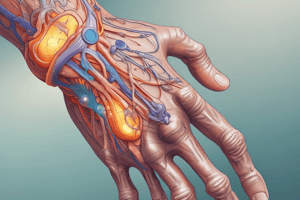Podcast
Questions and Answers
Quelle est la phase précoce de la PR ?
Quelle est la phase précoce de la PR ?
- Phase symptomatique précoce
- Phase pré-clinique (correct)
- Phase de prédisposition
- Phase établie
Qu'est-ce que le lupus érythémateux induit par les médicaments ?
Qu'est-ce que le lupus érythémateux induit par les médicaments ?
- Une maladie auto-immune
- Une maladie causée par une réaction allergique (correct)
- Une maladie causée par une carence en vitamines
- Une maladie causée par une infection
Quel est l'objectif du traitement de la PR ?
Quel est l'objectif du traitement de la PR ?
- Soulager la douleur
- Prévenir les déformations articulaires et arrêter la progression de la maladie (correct)
- Guérir la maladie
- Réduire l'inflammation
Quels sont les médicaments couramment associés au lupus érythémateux induit par les médicaments ?
Quels sont les médicaments couramment associés au lupus érythémateux induit par les médicaments ?
Quels sont les anticorps souvent présents dans le lupus érythémateux induit par les médicaments ?
Quels sont les anticorps souvent présents dans le lupus érythémateux induit par les médicaments ?
Quel est le rôle des cytokines dans la PR ?
Quel est le rôle des cytokines dans la PR ?
Quels sont les symptômes courants du lupus érythémateux induit par les médicaments ?
Quels sont les symptômes courants du lupus érythémateux induit par les médicaments ?
Quelle est la région la plus souvent touchée par la PR ?
Quelle est la région la plus souvent touchée par la PR ?
Que se passe-t-il lorsque le médicament est arrêté dans le lupus érythémateux induit par les médicaments ?
Que se passe-t-il lorsque le médicament est arrêté dans le lupus érythémateux induit par les médicaments ?
Quels sont les facteurs impliqués dans la pathogenèse de la PR ?
Quels sont les facteurs impliqués dans la pathogenèse de la PR ?
Quel est le marqueur spécifique de la PR ?
Quel est le marqueur spécifique de la PR ?
Que signifie l'acronyme aARMM dans le texte ?
Que signifie l'acronyme aARMM dans le texte ?
Quelles sont les manifestations extra-articulaires courantes de la PR ?
Quelles sont les manifestations extra-articulaires courantes de la PR ?
Quels sont les traitements mentionnés dans le texte pour le lupus érythémateux induit par les médicaments ?
Quels sont les traitements mentionnés dans le texte pour le lupus érythémateux induit par les médicaments ?
Qu'est-ce que l'ustekinumab ?
Qu'est-ce que l'ustekinumab ?
Quel est le test sanguin utilisé pour détecter le facteur rhumatoïde ?
Quel est le test sanguin utilisé pour détecter le facteur rhumatoïde ?
Quel est le test d'imagerie utilisé comme technique de deuxième ligne pour la PR ?
Quel est le test d'imagerie utilisé comme technique de deuxième ligne pour la PR ?
Flashcards are hidden until you start studying
Study Notes
- Polyarthrite rhumatoïde (PR) is a chronic and systemic inflammatory disease that affects the joints and can lead to bone erosion and extra-articular manifestations.
- It is the most common chronic inflammatory disease in the population and affects mainly women.
- The pathogenesis of PR involves genetic susceptibility, environmental factors, and modifications in immune cells.
- PR can be classified into four phases: susceptibility, pre-clinical, early symptomatic, and established.
- The disease is characterized by joint destruction, with the hands being the most commonly affected area.
- Other frequent manifestations include tenosynovitis, nodules, and extra-articular involvement such as pulmonary, neurological, and hematological complications.
- The goal of treatment is to prevent joint deformities and stop disease progression.
- There is no predictive marker for disease evolution.
- Cytokines play a role in the inflammatory response in PR, and treatment aims to restore the balance between pro- and anti-inflammatory cytokines.
- Early diagnosis is crucial for effective treatment.
- Polyarthrite rhumatoïde (PR) is an autoimmune disease that affects the joints.
- Early diagnosis and treatment can prevent irreversible joint damage.
- Diagnostic criteria include joint swelling, stiffness, and pain.
- Blood tests can detect factors such as rheumatoid factor (RF) and anti-cyclic citrullinated peptide (anti-CCP) antibodies.
- RF is associated with PR and other immune diseases, while anti-CCP is specific to PR.
- Radiology can show joint damage such as erosion and destruction.
- Ultrasound can detect synovitis and inflammation.
- MRI is used as a second-line imaging technique.
- PR can also affect other parts of the body, such as the lungs and heart.
- Treatment options include medication and lifestyle changes.
- Polyarthrite rhumatoïde is a chronic autoimmune disease that affects the joints.
- It can cause joint destruction, erosion, and inflammation.
- DAS 28-VS, CDAI, SDAI, HAQ, and EVA are used to measure disease activity.
- Mini-arthroscopy, synovial biopsy, histological analysis, and biomarkers are used for complementary examinations.
- ACPA, FR, extra-articular involvement, erosions, and inflammatory markers are bad prognosis factors.
- DMARDs and biologics are used for treatment.
- Methotrexate is a commonly prescribed DMARD.
- Fibrosis, aphtose des muqueuses, and liver/hepatic tests should be monitored during treatment.
- Biotherapies target different elements of the PR cascade.
- An algorithmic approach can be used for decision-making in treatment.
Studying That Suits You
Use AI to generate personalized quizzes and flashcards to suit your learning preferences.




